Class 9 MAHARASHTRA STATE TEXTBOOK BUREAU Solutions Maths Chapter 2 - Parallel Lines
Parallel Lines Exercise 2.1
Solution 1
(i)
∠DHP = 85° … (I)
∠DHP + ∠RHD = 180° … [Angles in a linear pair]
∴ 85° + ∠RHD = 180°
∴ ∠RHD = 180° - 85°
∴ ∠RHD = 95° … (II)
(ii)
∠PHG = ∠RHD … [Vertically opposite angles]
∴ ∠PHG = 95° … [From (II)]
(iii) Line RP || line MS and line DK is their transversal.
∴ ∠HGS = ∠DHP … [Corresponding angles]
∴ ∠HGS = 85° … [From (I)]
(iv)
∠HGS = 85° … (III)
∴ ∠MGK = ∠HGS … [Vertically opposite angles]
∴ ∠MGK = 85° … [From (III)]
Solution 2
Consider ∠e as shown in the figure.
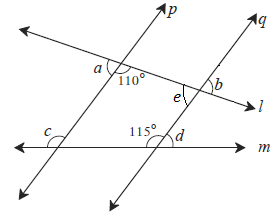
(i)
110o + ∠a = 180° … [Angles in a linear pair]
∴ ∠a = 180° - 110°
∴ ∠a = 70°
(ii)
Line p || line q, and line l is their transversal.
∴ ∠e + 110° = 180° … [Interior angles]
∴ ∠e = 180° - 110°
∴ ∠e = 70°
But, ∠b = ∠e … [Vertically opposite angles]
∴ ∠b = 70°
(iii)
Line p || line q, and line m is their transversal.
∴ ∠c = 115° … [Corresponding angles]
(iv)
115° + ∠d = 180° … [Angles in a linear pair]
∴ ∠d = 180° - 115°
∴ ∠d = 65°
Solution 3
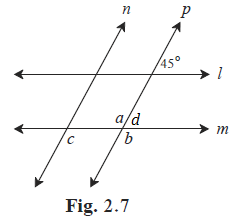
Consider ∠d as shown in the figure.
(i)
Line l || line m, and line p is their transversal.
∴ ∠d = 45° … [Corresponding angles]
Now, ∠d + ∠b = 180° … [Angles in a linear pair]
∴ 45° +∠b = 180°
∴ ∠b = 180° - 45°
∴ ∠b = 135° … (I)
(ii)
∠a = ∠b … [Vertically opposite angles]
∴ ∠a = 135° … [From (I)]
(iii)
Line n || line p, and line m is their transversal.
∴ ∠c = ∠b … [Corresponding angles]
∴ ∠c = 135° … [From (I)]
Solution 4
Given: Ray YZ || ray QR and ray YX || ray QP
To prove: ∠PQR ≅ ∠XYZ
Construction: Extend ray YZ in the opposite direction. It intersects ray QP at point S.
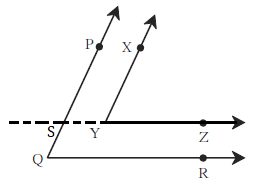
Proof:
Ray YX || ray QP … [Given]
Ray YX || ray SP and seg SY is their transversal [P-S-Q]
∴ ∠XYZ ≅ ∠PSY … (i) [Corresponding angles]
ray YZ || ray QR … [Given]
ray SZ || ray QR and seg PQ is their transversal [S-Y-Z]
∴ ∠PSY ≅ ∠SQR … [Corresponding angles]
∴ ∠PSY ≅ ∠PQR … (II) [P-S-Q]
∴ ∠PQR ≅ ∠XYZ … [From (I) and (II)]
Solution 5
(i)
∠BRT = 105° … (I)
∠ART + ∠BRT = 180° … [Angles in a linear pair]
∴ ∠ART + 105° = 180°
∴ ∠ART = 180° - 105°
∴ ∠ART = 75° … (II)
(ii)
Line AB || line CD and line PQ is their transversal.
∴ ∠CTQ = ∠ART … [Corresponding angles]
∴ ∠CTQ = 75° … [From (II)]
(iii)
Line AB || line CD and line PQ is their transversal.
∴ ∠DTQ = ∠BRT … [Corresponding angles]
∴ ∠DTQ = 105° … [From (I)]
(iv)
∠PRB = ∠ART … [Vertically opposite angles]
∴ ∠PRB = 75° … [From (II)]
Parallel Lines Exercise 2.2
Solution 1
Given: y = 108°, x = 71°
Now, x + y = 71° + 108° = 179°
∴ x + y ≠ 180°
∴ The angles x and y are not supplementary.
∴ The angles do not satisfy the interior angles test for parallel lines.
∴ line m and line n are not parallel lines.
Solution 2
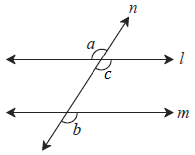
Consider ∠b as shown in the figure.
Given: ∠a ≅ ∠b
To prove: line l| line m
Proof:
Now, ∠a ≅ ∠c … (I) [Vertically opposite angles]
But, ∠a ≅ ∠b … (II) [Given]
∴ ∠b ≅ ∠c … [From (I) and (II)]
But, ∠b and ∠c are corresponding angles on lines l and m when line n is the transversal.
∴ line l || line m … [Corresponding angles test]
Solution 3
Given: ∠a ≅ ∠b and ∠x ≅ ∠y
To prove: line l | line n
Proof:
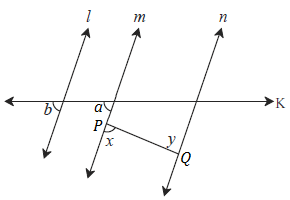
∠a = ∠b … [Given]
But, ∠a and ∠b are corresponding angles on lines l and m when line K is the transversal.
∴ line l || line m … (I) [Corresponding angles test]
Also, ∠x ≅ ∠y … [Given]
But, ∠x and ∠y are alternate angles on lines m and n when seg PQ is the transversal.
∴ line m || line n … (II) [Alternate angles test]
∴ From (I) and (II),
line l || line m || line n
i.e., line l || line n
Solution 4
Draw a line FG passing through point C and parallel to line AB
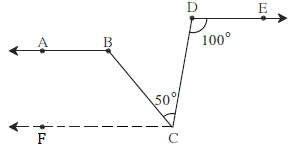
Line FC || ray BA … (I) [Construction]
Ray BA || ray DE … (II) [Given]
Line FC || ray BA || ray DE … (III) [From (I) and (II)]
∴ Line FC || ray DE and seg DC is their transversal
∴ ∠ DCF = ∠ EDC … [Alternate angles]
∴ ∠ DCF = 100° … [∵ ∠D = 100°]
Now, ∠ DCF = ∠ BCF + ∠ BCD … [Angle addition property]
∴ 100° = ∠BCF + 50°
∴ 100° - 50° = ∠BCF
∴ ∠BCF = 50° … (IV)
Now, line FC || ray BA and seg BC is their transversal.
∴ ∠ABC + ∠BCF = 180° … [Interior angles]
∴ ∠ABC + 50° = 180° … [From (IV)]
∴ ∠ABC = 180° - 50°
∴ ∠ABC = 130°
Solution 5
Given: Ray AE || ray BD, and ray AF and ray BC are the bisectors of ∠EAB and ∠ABD respectively.
To prove: line AF || line BC
Proof:
Ray AE || ray BD and seg AB is their transversal.
∴ ∠EAB = ∠ABD … (I) [Alternate angles]
∠FAB = ½ ∠EAB … [Ray AF bisects ∠EAB]
∴ 2∠FAB = ∠EAB … (II)
∠CBA = ½ ∠ABD … [Ray BC bisects ∠ABD]
∴ 2∠CBA = ∠ABD … (III)
∴ 2∠FAB = 2∠CBA [From (I), (II) and (III)]
∴ ∠FAB = ∠CBA
But, ∠FAB and ∠ABC are alternate angles on lines AF and BC when seg AB is the transversal.
∴ line AF || line BC … [Alternate angles test]
Solution 6
Given: Ray PR || ray QS and Ray PR and ray QS are the bisectors of ∠BPQ and ∠PQC respectively.
To prove: line AB || line CD
Proof:
Ray PR || ray QS and seg PQ is their transversal.
∠RPQ = ∠SQP … (I) [Alternate angles]
∠RPQ = ½ ∠BPQ … (II) [Ray PR bisects ∠BPQ]
∠SQP = ½ ∠PQC … [Ray QS bisects ∠PQC]
∴ ½ ∠BPQ = ½ ∠PQC
∴ ∠BPQ = ∠PQC
But, ∠BPQ and ∠PQC are alternate angles on lines AB and CD when line EF is the transversal.
∴ line AB || line CD … [Alternate angles test]
Parallel Lines Exercise Problem Set 2
Solution 1(i)
(C)
If a transversal intersects two parallel lines then the sum of interior angles on the same side of the transversal is 180o.
Solution 1(ii)
(C)
The number of angles formed by a transversal of two lines is 8.
Solution 1(iii)
(A)
A transversal intersects two parallel lines. If the measure of one of the angles is 40° then the measure of its corresponding angle is 40o.
Solution 1(iv)
(B)
In ∆ ABC, ∠A + ∠B + ∠C = 180°
∴ ∠C = 180° - ∠A - ∠B = 180° - 76° - 48° = 56°
∴ ∠C = 56°
Solution 1(v)
(A)
Two parallel lines are intersected by a transversal. If measure of one of the alternate interior angles is 75° then the measure of the other angle is 105°.
Solution 2

(i)
Complementary angles:
∠RPQ = 90° … [Ray PQ ⊥ ray PR]
∴ ∠RPB + ∠BPQ = 90° … [Angle addition property]
∴ ∠RPB and ∠BPQ are pair of complementary angles.
Also, ∠APB = 90° … [Ray PA ⊥ ray PB]
∴ ∠APR + ∠RPB = 90°
∴ ∠APR and ∠RPB are pair of complementary angles.
(ii)
Supplementary angles:
∠APB + ∠RPQ = 90° + 90° = 180°
∴ ∠APB and ∠RPQ are pair of supplementary angles.
(iii)
Congruent angles:
∠APB = ∠RPQ … [Each of 90°]
∴ ∠APR + ∠RPB = ∠RPB + ∠BPQ … [Angle addition property]
∴ ∠APR = ∠BPQ
∴ ∠APR ≅ ∠BPQ
Solution 3
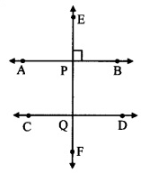
Given:
Line AB || line CD and line EF intersects them at P and Q respectively.
Line EF ⊥ line AB
To prove: line EF ⊥ line CD
Proof:
Line EF ⊥ line AB … [Given]
∴ ∠EPB = 90° … (I)
Line AB || line CD and line EF is their transversal.
∴ ∠EPB ≅ ∠PQD … (II) [Corresponding angles]
∴ ∠PQD = 90° … [From (I) and (II)]
∴ line EF ⊥ line CD
Solution 4
∠x = 130° … [Vertically opposite angles]
∠y = 50° … [Vertically opposite angles]
Here, m∠ABC + m∠BCD = 130° + 50° = 180°
But, ∠ABC and ∠BCD are a pair of interior angles on lines l and m when line n is the transversal.
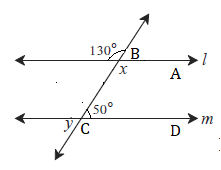
∴ line l || line m … [Interior angles test]
Solution 5
Given: y : z = 3 : 7
Let the common multiple be k
∴ ∠y = 3k and ∠z = 7k … (I)
Line AB || line EF and line PQ is their transversal … [Given]
∴ ∠x = ∠z
∴ ∠x = 7k … (II) [From (I)]
Line AB || line CD and line PQ is their transversal … [Given]
∴ ∠x + ∠y = 180°
∴ 7k + 3k = 180°
∴ 10k = 180°
∴ k = 18°
∴ ∠x = 7k = 7(18°) … [From (II)]
∴ ∠x = 126°
Solution 6
Given: ∠a = 80°
Now, ∠g = ∠a … [Alternate exterior angles]
∴ ∠g = 80° … (I)
Now, line q || line r and line p is their transversal.
∴ ∠f + ∠g = 180° … [Interior angles]
∴ ∠f + 80° = 180° … From (I)
∴ ∠f = 180° - 80°
∴ ∠f = 100°
Solution 7
Given: line AB || line CF and line BC || line ED
To prove: ∠ABC = ∠FDE
Proof:
Line AB || line PF and line BC is their transversal.
∴ ∠ABC = ∠BCD … (I) [Alternate angles]
Line BC || line ED and line CD is their transversal.
∴ ∠BCD = ∠FDE … (II) [Corresponding angles]
∴ ∠ABC = ∠FDE … [From (I) and (II)]
Solution 8
Given: line AB || line CD
Rays QX, RX, QY, RY are the bisectors of ∠AQR, ∠QRC, ∠BQR and ∠QRD respectively.
To prove: □QXRY is a rectangle.
Proof:
∠XQA = ∠XQR = x° … (I) [Ray QX bisects ∠AQR]
∠YQR = ∠YQB = y° … (II) [Ray QY bisects ∠BQR]
∠XRQ = ∠XRC = u° … (III) [Ray RX bisects ∠CRQ]
∠YRQ = ∠YRD = v° …(IV) [Ray RY bisects ∠DRQ]
Since, line AB || line CD and line PS is their transversal.
∴ ∠AQR+ ∠CRQ = 180° … [Interior angles]
∴ (∠XQA + ∠XQR) + (∠XRQ + ∠XRC) = 180° … [Angle addition property]
∴ (x + x) + (u + u) = 180° … [From (I) and (II)]
∴ 2x + 2u = 180°
∴ 2(x + u) = 180°
∴ x + u = 90° … (V)
In ∆XQR,
∠XQR + ∠XRQ + ∠QXR = 180° … [Sum of the measures of the angles of triangle is 180°]
∴ x + u + ∠QXR = 180° … [From (I) and (III)]
∴ 90 + ∠QXR = 180° … [From (V)]
∴ ∠QXR = 180° - 90°
∴ ∠QXR = 90° … (VI)
Similarly, we can prove that,
∴ y + v = 90°
i.e. ∠QYR = 90° … (VII)
Now, ∠AQR + ∠BQR = 180° … [Angles is linear pair]
∴ (∠XQA + ∠XQR) + (∠YQR + ∠YQB) = 180° … [Angle addition property]
∴ (x + x) + (y + y) = 180° … [From (I) and (II)]
∴ 2x + 2y = 180°
∴ 2(x + y) = 180°
∴ x + y = 90°
i.e. ∠XQR + ∠YQR = 90° … [From (I) and (II)]
∴ ∠XQY = 90° … (VIII) [Angle addition property]
Similarly, we can prove that,
∠XRY = 90° … (IX)
In □QXRY,
∠QXR = ∠QYR = ∠XQY = ∠XRY = 90° … [From (vi), (vii), (viii) and (ix)]
∴ □QXRY is a rectangle.

